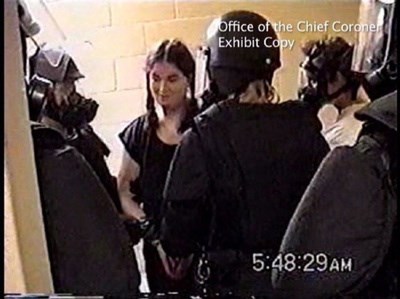
.
January 23, 2013 - 12:05 PM
TORONTO - A lengthy videotaped standoff screened for inquest jurors Wednesday highlighted the difficulties front-line prison staff had coping with a deeply disturbed teenager who later strangled herself.
On this occasion in June 2007, Ashley Smith had inadvertently been let out of her segregation cell when a correctional officer mistakenly unlocked her cell door by remote.
Smith, who had a history of tying ligatures around her neck, retrieved towels, sheets or other items from a nearby washing machine and retreated back into the cell, prompting the standoff.
"Ashley's behaviour was not typical inmate behaviour," Correctional Officer Blaine Phibbs testified.
"I'd never seen anything like her."
Phibbs and other guards are seen in the video pleading with Smith through her segregation cell door.
They urge her to uncover the observation window, to hand over the items she had. Smith does not co-operate.
"Ashley, listen to me for a second."
"Ashley. Take the sheet off the window."
Smith, firmly, even politely, refuses.
The guards, worried Smith had ligatures she could choke herself with, try to bribe her into giving the items up.
"Whatcha doing? How many pieces you got?"
Occasionally, Smith swears at the officers. Mostly she is calm, answering or bantering with them in a thin-girlie voice.
Why not just go into her cell and remove the items? Jocelyn Speyer, coroner's counsel, asked Phibbs.
"Because it was 'least restrictive'," Phibbs responded.
"She wasn't harming herself or anyone else at that time."
Smith eventually appeared to comply with the requests, pushing towels or sheets through the food slot in the heavy grey door.
At one point, guards hand her toilet paper through the slot.
"I don't want you watching me," Smith calls out.
"I won't."
"Promise?"
"Promise."
Officers had no legal basis on which to try to remove ligatures they feared Smith had secreted in a body cavity, Phibbs testified.
Ligatures, he said, were classified as an unauthorized item, rather than contraband.
"We had no right to go in and remove it. We couldn't see it. She wasn't in any harm," he said.
"I know our warden would never have consented to a cavity search. No matter what the situation."
Sounding like the father of a difficult teen, Phibbs banters with Smith about a local FM radio station. They talk about trying to get her to a psychiatric hospital.
Smith, Phibbs testified, did not want to be at the prison.
Finally, well over an hour in, five guards eventually entered the small cell.
"Stay still, Ashley!"
"OK."
"Thank you."
Smith, on the floor in a security gown, resists as guards try to remove pieces of cloth from her.
"I have OC (pepper-like) spray. I will use it against you," a female guard warns.
"I don't want you touching me," Smith protests. "Pull my dress down."
"I'm not looking, don't worry," Phibbs says.
Why did so many guards have to go into the cell? Speyer asked.
"She was a big girl. She was aggressive. She was strong. She was combative," Phibbs said.
Everything was video recorded to "protect ourselves and for her," the witness told the five-women jury, because of the frequency of such incidents and because Smith had previously hurt guards.
At the time of the video, Smith had spent about three years behind bars, most of it in segregation.
On a subsequent stay at Grand Valley, Smith, 19, of Moncton, N.B., would eventually choke herself to death on Oct. 19, 2007, as guards videotaped but did not intervene.
News from © The Canadian Press, 2013